|

|
|
|
|
Monday,
February 6, 2006

 The
Point Huitzil Route - The
winter continues to be dry and great hiking opportunities abound in
the Grand Canyon. This past Saturday, I went up to the South
Bass area with a group to hike down the bizarre route at Point
Huitzil, and then follow the Esplanade to the South Bass trail and
out. The route is marked by a secretive hole in the cliff, a
crack in the rock that you must descend, a huge rock art panel and
ancient footholds. To read about this hike, and see more photos,
go to my extended blog "Point
Huitzil to the South Bass Trail." The
Point Huitzil Route - The
winter continues to be dry and great hiking opportunities abound in
the Grand Canyon. This past Saturday, I went up to the South
Bass area with a group to hike down the bizarre route at Point
Huitzil, and then follow the Esplanade to the South Bass trail and
out. The route is marked by a secretive hole in the cliff, a
crack in the rock that you must descend, a huge rock art panel and
ancient footholds. To read about this hike, and see more photos,
go to my extended blog "Point
Huitzil to the South Bass Trail."
| Click
on any picture to see a larger image. |
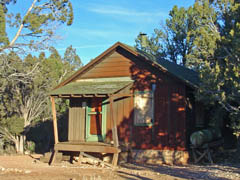 |
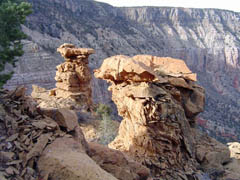 |
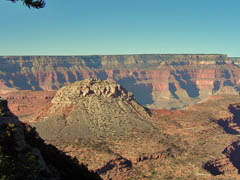 |
|
Abandoned
range station. |
Toroweap
towers at Pt. Huitzil. |
Mt.
Huethawali from South Bass. |
|
|

|
|
Saturday,
February 11, 2006
  Freedoms,
Collectivism and Cartoons
- The
"cartoon jihad" that is rocking the Muslim world has, I
hope, shocked many in the western world. If you haven't seen
these cartoons, follow the link to the right. [The image and
link from Michelle Malkin's site.] They range from the trivial
to the humorous to the critical. This episode contains lessons
galore for our present age. Other blogs have done an excellent
job of drawing out these lessons (pun intended), but I'd like to weigh
in on this issue, with comments that you might not have pondered in
this regard. Freedoms,
Collectivism and Cartoons
- The
"cartoon jihad" that is rocking the Muslim world has, I
hope, shocked many in the western world. If you haven't seen
these cartoons, follow the link to the right. [The image and
link from Michelle Malkin's site.] They range from the trivial
to the humorous to the critical. This episode contains lessons
galore for our present age. Other blogs have done an excellent
job of drawing out these lessons (pun intended), but I'd like to weigh
in on this issue, with comments that you might not have pondered in
this regard.
Tolerance
is not always a virtue.
Some have argued that "we" need to be tolerant of religious
beliefs, like the prohibition, in Islam, against caricatures of
Muhammad. I have no problem "respecting" another
person's belief system, as long as they don't try to impose those
beliefs on me. If Muslims want to deny themselves in this way
(and it isn't clear that this is necessary - Zombie
has an excellent compendium of illustrations of Muhammad that have
been done over the ages, many of which come from the Muslim
world). The "toleration" that has been urged in this
regard (including that of the U.S. State Department) is really the
same type of toleration practiced by Neville
Chamberlain. That is, allowing others to proscribe our
rights, through threats and intimidation. Such
"tolerance" is not a virtue.
Principles
are not always a vice.
Either we believe in liberty and freedom, or we don't. Trying to
slice and dice liberty so that it is not "offensive" to some
has, I thought, been thoroughly discredited. [Well, maybe not at
NAU.] You have the
right to be stupid and you have the right to say stupid things.
Freedom of speech is not reserved just for the speech that we agree
with. I always thought that was the point. I was dismayed
that the editor of our local paper chose to defend the prohibition of
printing these cartoons on the grounds that they were bigoted.
Well, he is entitled to his opinion, even if he is wrong. And,
the newspaper belongs to its owners and they can decide what to print
and what not to print. The point of the cartoons was to show
that we do enjoy, and practice, our freedoms. And, recall the
episode of Salman
Rushdie - he used prose to mock Muhammad, and for that he earned a
fatwa calling for his assassination. In other words, while
written criticism may not be explicitly prohibited, Muslim religious
leaders can make exceptions.
It's
collectivism vs. individualism, stupid.
The underlying issue is not religion or tolerance. It really is
about the fundamental conflict between collectivism and
individualism. Our freedoms are based on a perception that
individualism is the primary value to be upheld, protected and
defended. Collectivism is the polar opposite of individualism;
it controls, dictates and proscribes. A collectivist state, be
it a brutal dictatorship, a communist regime or a theocracy, cannot abide
individuality. The individual is a threat to the power of the
collective. Collectivism
is premised on force - the power of the state to compel you to use
your life, your abilities, your resources, in a manner determined by
others. Arguing
that it "takes a village" is arguing that you have
obligations to the collective; obligations that you will be forced to
fulfill. In her book, Anthem,
Ayn Rand has a passage that does an excellent job of explaining what
freedom means:
I do not surrender my treasures, nor do I share them. The fortune of my spirit is not to be blown into coins of brass and flung to the winds as alms for the poor of the spirit. I guard my treasures: my thought, my will, my freedom. And the greatest of these is freedom.
I owe nothing to my brothers, nor do I gather debts from them. I ask none to live for me, nor do I live for any others. I covet no man's soul, nor is my soul theirs to covet.
I am neither foe nor friend to my brothers, but such as each of them shall deserve of me. And to earn my love, my brothers must do more than to have been born. I do not grant my love without reason, nor to any chance passer-by who may wish to claim it. I honor men with my love. But honor is a thing to be
earned. |
As
man evolved, the tribal/collective structure was successful at
allowing humans to survive in a world that is beset by forces that
would kill us off - freezing temperatures, diseases, predators,
difficulty in acquiring food, clothing and shelter. But, as
we have progressed, this tribal structure has ceased to be relevant to
our continued development, and, indeed, it acts as a barrier. I
remember an exchange between one of my grad school professors and a
visiting economist from South Africa (before they abandoned
apartheid). The visitor was talking about how the government was
encouraging people to live in their own tribal groups in order to
better spur economic development, to which my professor remarked that
it seemed to him that tribalism was Africa's biggest impediment to
economic development and suggested that maybe it would be better to
blur these distinctions. That was many years ago, well before
the carnage in Dafur,
or the atrocities in Rwanda.
I think he, my professor, was right. As the "cartoon
jihad" shows us, throwing off the shackles of tribalism (whether
based on ethnicity or religion or some other factor) is going to take
some time.
A final thought, albeit a light one - why not invent a character that
is not Muhammad, but who stands for him? We could call him, oh,
how about "Brian." [Yes, I do get inspiration from
Monty Python.] Would Muslims be offended by cartoons of
Brian? Hmm, I wonder ...
|
|

|
|
Sunday,
February 12, 2006

 The
Winter Cabin Trail in Sycamore Canyon
- With
the mild winter we are having in northern Arizona, my blog has become
half political/social commentary and half hiking
stories/pictures. Well, I can't do anything about the weather,
so I'm on a tear with regard to getting outside and wandering
about. This weekend The
Winter Cabin Trail in Sycamore Canyon
- With
the mild winter we are having in northern Arizona, my blog has become
half political/social commentary and half hiking
stories/pictures. Well, I can't do anything about the weather,
so I'm on a tear with regard to getting outside and wandering
about. This weekend 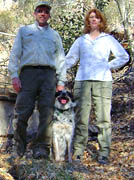 (today),
Cara Lynn and Scout and I did a day hike in the Sycamore Canyon
Wilderness Area, which is south and west of Flagstaff. One can
access the lower end from the Verde Valley, west of Sedona, while the
upper end is quite close to Flagstaff. We decided (well, Scout
had no say in the matter) to do the Winter Cabin Trail, which is about
25 miles out of town, over dirt roads that get progressively worse the
closer you get. And, during a "normal" winter, they
would be snowy and icy, at best, and impassable, at worse. (today),
Cara Lynn and Scout and I did a day hike in the Sycamore Canyon
Wilderness Area, which is south and west of Flagstaff. One can
access the lower end from the Verde Valley, west of Sedona, while the
upper end is quite close to Flagstaff. We decided (well, Scout
had no say in the matter) to do the Winter Cabin Trail, which is about
25 miles out of town, over dirt roads that get progressively worse the
closer you get. And, during a "normal" winter, they
would be snowy and icy, at best, and impassable, at worse.
The trail leads 1.5 miles to the namesake Winter Cabin, located along
a small spring. Another 1.5 miles takes you to Ott Lake, which
has no water, but ought to! Lots of elk tracks here, and
elsewhere in the area, although we didn't see any today. We did
see about 20 turkeys scurrying about near one of the many tanks that
dot the landscape on the rim. They were huge and I was surprised
to see so many together.
The day was beautiful - clear blue skies, and highs probably in the
upper 50s. It was cool in the shade, and warm in the sun.
We both got a bit of a sunburn on our hands and faces! Well,
that should teach us a lesson. There was nobody else on the
trail, or even in the area. The last trail register entry was
for February 6, and that was made by someone from the Forest
Service. In the last month, only four groups signed into the
register. So, it was a very relaxing and peaceful hike.
There were a few woodpeckers about, and we did see many small birds
flying around at Ott Lake, which was as far as we hiked. We
started down the trail at about 11 a.m. and returned to the trailhead
at just past 4 p.m.
|
|

|
|
Friday,
February 17, 2006
 When
Life Gives You Lemons
- Hey, I like Dick Cheney! When
Life Gives You Lemons
- Hey, I like Dick Cheney!

|
|

|
|
Monday,
February 20, 2006

 The
Path to Liberty
- Such was the title of the 3-day lecture series presented by the
Foundation for Economic Education (FEE)
in Scottsdale, Arizona this past weekend. The lectures, a
sampling of FEE's student seminars, offered each summer at their New
York home, ranged from "The
Miracle and Morality of the Market"
to "Private
Education Instead of Government Schooling"
to "Utopia in
Power: The Soviet Tragedy."
The presentations were given by Richard Ebeling, President of FEE,
Anna Ebeling and Sheldon Richman (pictured above, right to left). The
Path to Liberty
- Such was the title of the 3-day lecture series presented by the
Foundation for Economic Education (FEE)
in Scottsdale, Arizona this past weekend. The lectures, a
sampling of FEE's student seminars, offered each summer at their New
York home, ranged from "The
Miracle and Morality of the Market"
to "Private
Education Instead of Government Schooling"
to "Utopia in
Power: The Soviet Tragedy."
The presentations were given by Richard Ebeling, President of FEE,
Anna Ebeling and Sheldon Richman (pictured above, right to left).
Certainly, this event was a case of "preaching to the choir"
since those in attendance were already strong supporters of the
libertarian cause. I don't know if the audience was also
well-schooled in basic economics, but many, like myself, were
teachers, either in the public schools or in the university
environment. For me, the highlights were the presentations by
Anna Ebeling, who was born and raised in Soviet Russia. She gave
presentations on the history of liberty and the history of
collectivism, as expressed in the writings of philosophers, scholars
and others. My knowledge in this area is not very broad, and I
appreciated her tour de force of this subject matter.
What really riveted us were Anna's stories of growing up in the
communist state. She told us about being disabused, by her
parents, of the notion that Lenin was her grandfather, which was
standard propaganda "taught" to grade school children
("Here is a picture of your grandfather - Lenin killed him;
here is a picture of your other grandfather - Stalin killed
him."). She talked of her grandmother, who literally tried
to take food to starving peasants in the Ukraine during the time when
Stalin's brutal collectivization
was killing millions. To read about the ideas of liberty and
freedom, she joined with others to hand-copy and distribute such
subversive literature as The
Law, by Frederic
Bastiat, and Animal
Farm, by George
Orwell, the latter of which lead to her detention and interrogation by
the KGB. One of the most memorable lines, at least to me, was:
|
Intellectuals
claim that the problem with the Soviet Union was that they had
stopped following Marx. That is not true. I know;
I lived there. We followed the bastard! |
While most of FEE's activities take place at their home in New York,
there are occasional events, like this one, that are held around the
country, allowing like-minded people to get together to re-invest
their energies and efforts in promoting the ideals of freedom and
liberty. And, FEE maintains a web site, where you can find many
books and essays posted up (usually in pdf format) in their Freedom
Library - no card required! Another resource, which has a
more extensive collection, is the Online
Library of Liberty.
|
|

|
|
Friday,
February 24, 2006
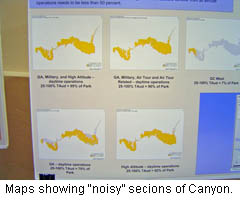  Noisy
Grand Canyon?
- This past Wednesday, a public scoping session was held at the
nearby Museum of Northern Arizona regarding an upcoming EIS
(Environmental Impact Statement) process that will likely further
limit and constrain overflights at the Grand Canyon. The topic
is "noise" but the issue is really one of control. The
major parties in this process are the FAA
and the NPS.
So far, they seem to be following different agendas, and I hope that
the FAA can retain the upper hand here. Noisy
Grand Canyon?
- This past Wednesday, a public scoping session was held at the
nearby Museum of Northern Arizona regarding an upcoming EIS
(Environmental Impact Statement) process that will likely further
limit and constrain overflights at the Grand Canyon. The topic
is "noise" but the issue is really one of control. The
major parties in this process are the FAA
and the NPS.
So far, they seem to be following different agendas, and I hope that
the FAA can retain the upper hand here.
This session was really about letting people know what the issues are
and to encourage comments before an EIS is first issued, which would,
then, detail several alternatives and subject them to closer public
scrutiny. I don't really have any idea how important this
scoping process is in determining the shape of the EIS. My view
is that most of the entire EIS process is used to justify decisions
made by bureaucrats and politicians, and that the public's role in all
this is mostly illusory. For example, when resources are
"impacted," as they inevitably are, the federal agency will
claim that these impacts can be "mitigated" when they really
want to pursue a particular proposal. If they are opposed to a
particular outcome, then these impacts are deemed serious and
detrimental.
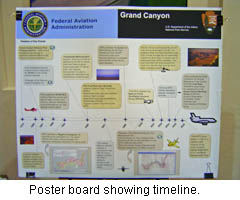 Still, representatives from the Sierra Club had flyers at this
session, promoting their own view on this matter. As you might
suspect, they favor fewer overflights. Their "talking
points" flyer exhorts participants to write "thousands of
comment letters in support of natural quiet at the Canyon."
Clearly, they believe that such public pressure would influence the
course of events. Interestingly, the same flyer also maintains
that the EIS process should not revisit the meaning of the phrases
"natural quiet" and "substantial restoration of the
natural quiet." If the process must assume the meaning of
"natural quiet" then why is the Sierra Club urging people to
write letters in support of such quiet? I can only infer that
the meaning of these phrases is, in fact, still up to debate.
Still, representatives from the Sierra Club had flyers at this
session, promoting their own view on this matter. As you might
suspect, they favor fewer overflights. Their "talking
points" flyer exhorts participants to write "thousands of
comment letters in support of natural quiet at the Canyon."
Clearly, they believe that such public pressure would influence the
course of events. Interestingly, the same flyer also maintains
that the EIS process should not revisit the meaning of the phrases
"natural quiet" and "substantial restoration of the
natural quiet." If the process must assume the meaning of
"natural quiet" then why is the Sierra Club urging people to
write letters in support of such quiet? I can only infer that
the meaning of these phrases is, in fact, still up to debate.
The issue here quickly degenerates into the absurd since the
"problem" of noise is independent of people. That is,
if a plane flies over the canyon, and nobody hears it, "natural
quiet" has been disturbed and, so, it must be prohibited.
It is a concept that just boggles my mind. There is probably
some sort of philosophical paradox involved here, but I don't know if
it has a name.
Also, there is the question of what it means to have "natural
quiet." The park service goal is stated like this:
| Natural quiet is obtained when, "substantial restoration requires that 50% or more of the park achieve "natural quiet" (i.e., no aircraft audible) for 75-100 percent of the day, each and every day."
[link] |
It doesn't take a rocket scientist to see that this definition is
arbitrary in the extreme. What is magical about 50% of the
park? Why not 65%? Or, 42%? And, why for 75%-100% of
the day? As if that wasn't enough, the park service defines a
"day" as being "the
12 hour daylight period." For what purpose?
Clearly, it is subterfuge, designed to make the 50% and 75% figures
more palatable to the public.
I had thought on the question of "noise" while I was hiking
in the Kanab Creek Wilderness Area in early January. One day I
just did some easy day hiking, over to Indian Hollow Spring and out
along the plateau by Racetrack Knoll. I decided to put on my MP3
player and listen to tunes all day. The thing is so light that,
even though I don't listen often, it is worth carrying to listen to occasionally.
Anyway, while I was listening to BTO and Jethro Tull, among others, I
thought, "Why not let people download 'natural quiet' onto their
MP3 players? Then, they can enjoy the natural quiet as much as
they want!"
At the scoping session, I decided to write a comment, although I don't
have any expectation that it will receive any consideration.
But, here is the essence:
Include
a market-based option in the EIS study. Identify
as many overflight routes as is practical (and, safe) over the Grand
Canyon and auction off the rights to these routes. They may be
auctioned off every year, or for multiple years. If there are
people who would like to preserve the "natural quiet" of the
Grand Canyon, they can buy these rights, either as individuals, or
through groups like the Sierra Club. There are two advantages
from such an approach. First, instead of using the political
process to determine how best to use the resource (and, probably
getting it wrong), interested parties can express the strength of
their views by participating in this auction, insuring that the
resource goes to its highest valued use, be it for air tours or
not. Secondly, the money from such an auction could be used to
enhance and improve the park, for all visitors, without raising
entrance fees.
I have also submitted this comment to the FAA via their on-line web
page. If you would like add your two cents worth, click on the
image, below, to do so. [Click on either photo, above, to see a
larger image.]

|
|

|
|
Tuesday,
February 28, 2006
 Local
Roundup - Late February
- Despite my best efforts . . . well, despite my efforts, best or
otherwise, local issues worthy of some comment pass by me in the
hustle and bustle of life. I really don't know how the
blogmeister at CoyoteBlog gets
so much written (and, written well) when he is also running his own
business! And, all I have to do is teach a couple of classes at
the university. Well, that is about 150 students and I have been
giving them a reasonably heavy dose of homework so far this
term. And, I have been hiking practically every weekend during
this new year. Still, I am compelled to offer my 2¢ worth on
matters close to hand - any quotes come from the Arizona Daily Sun for
the date cited. And, by the way, why isn't the cents symbol on
the keyboard anymore? Was it ever on a computer keyboard?
I do remember, distinctly, that it was on the old typewriters - did it
get replaced by the @ symbol? ... Local
Roundup - Late February
- Despite my best efforts . . . well, despite my efforts, best or
otherwise, local issues worthy of some comment pass by me in the
hustle and bustle of life. I really don't know how the
blogmeister at CoyoteBlog gets
so much written (and, written well) when he is also running his own
business! And, all I have to do is teach a couple of classes at
the university. Well, that is about 150 students and I have been
giving them a reasonably heavy dose of homework so far this
term. And, I have been hiking practically every weekend during
this new year. Still, I am compelled to offer my 2¢ worth on
matters close to hand - any quotes come from the Arizona Daily Sun for
the date cited. And, by the way, why isn't the cents symbol on
the keyboard anymore? Was it ever on a computer keyboard?
I do remember, distinctly, that it was on the old typewriters - did it
get replaced by the @ symbol? ...
 Set a fire in
a private school - go directly to a public school.
Two students at Northland
Preparatory Academy (grades 7-12) set a fire at their school and,
rightfully, got bounced out. And, now? Why, they have
enrolled in the Flagstaff Public Schools! The public school
system superintendent was paraphrased as saying, "Even if a
student is found guilty of committing a crime, that does not affect
the student's right to attend public school." Yes, it's
crazy time here in Flagstaff. This case does a great job of
illustrating the argument that compulsory education is not a proper
role of the government. By making it compulsory, we not only
weaken incentives to do a good job in educating students, we promote
the schools as just a place to park children until they reach the age
of 18. [02/26/2006]
Set a fire in
a private school - go directly to a public school.
Two students at Northland
Preparatory Academy (grades 7-12) set a fire at their school and,
rightfully, got bounced out. And, now? Why, they have
enrolled in the Flagstaff Public Schools! The public school
system superintendent was paraphrased as saying, "Even if a
student is found guilty of committing a crime, that does not affect
the student's right to attend public school." Yes, it's
crazy time here in Flagstaff. This case does a great job of
illustrating the argument that compulsory education is not a proper
role of the government. By making it compulsory, we not only
weaken incentives to do a good job in educating students, we promote
the schools as just a place to park children until they reach the age
of 18. [02/26/2006]
 Don't like
your homework? Just lodge a complaint.
The Arizona
state legislature is considering a bill that would allow students to
opt out of assigned readings that they found "personally
offensive or pornographic." Oh, yes, this is a good
idea. Well, this is another example of what government shouldn't
do - subsidize higher education. Let the market rule and
students can go to any college they want to. Or, at least, to
any college that will accept them. And, if the student doesn't
like the assignments, they can leave and go elsewhere. And, if
most of them do so, the college will can the professor and change the
curriculum. Isn't the market a wonderful thing?
[02/20/2006]
Don't like
your homework? Just lodge a complaint.
The Arizona
state legislature is considering a bill that would allow students to
opt out of assigned readings that they found "personally
offensive or pornographic." Oh, yes, this is a good
idea. Well, this is another example of what government shouldn't
do - subsidize higher education. Let the market rule and
students can go to any college they want to. Or, at least, to
any college that will accept them. And, if the student doesn't
like the assignments, they can leave and go elsewhere. And, if
most of them do so, the college will can the professor and change the
curriculum. Isn't the market a wonderful thing?
[02/20/2006]
 It's official
- watering restrictions lifted during the driest winter ever!
Well, I don't
know if it is the driest winter ever, but there are still great hiking
opportunities on the San Francisco Peaks. We have been laboring
under mandatory water restrictions for a couple of years now, and
you'd think that with our dry winter, there would be even more
restrictions. But, no! The city council has decided to
suspend the restrictions on daytime watering (but, I don't know if the
even/odd restrictions are still in place) until mid-April. Of
course, most folks are scratching their heads over this one.
This would be an excellent area to privatize and let the market price
the water according to what is available and what is demanded.
If people want to go around door-to-door proselytizing for residents
to conserve water, then that's fine with me. But, for heaven's
sake, let's fire the city's "water conservation manager" and
keep church and state separate. [02/19/2006]
It's official
- watering restrictions lifted during the driest winter ever!
Well, I don't
know if it is the driest winter ever, but there are still great hiking
opportunities on the San Francisco Peaks. We have been laboring
under mandatory water restrictions for a couple of years now, and
you'd think that with our dry winter, there would be even more
restrictions. But, no! The city council has decided to
suspend the restrictions on daytime watering (but, I don't know if the
even/odd restrictions are still in place) until mid-April. Of
course, most folks are scratching their heads over this one.
This would be an excellent area to privatize and let the market price
the water according to what is available and what is demanded.
If people want to go around door-to-door proselytizing for residents
to conserve water, then that's fine with me. But, for heaven's
sake, let's fire the city's "water conservation manager" and
keep church and state separate. [02/19/2006]
 Will Chinese
water-less torture be next?
The city, in its
unfathomable wisdom, has also decided that all new buildings in
Flagstaff, and remodeled ones, will have to use waterless
urinals. Why can't it be up to the individual builder and/or
tenant? Why does the city get to decide whether you can, or
cannot, use water in a urinal? We have installed just such
devices at the new College of Business Administration at Northern
Arizona University. Oddly enough, the toilets seem to use about
100 gallons per flush. It seems to me that a happier medium
could have been reached here. And, with no daytime custodial
staff in the building, the men's rooms do start to smell a bit like
hamster cages - that is probably not featured in the city's propaganda
extolling the virtues of conserving water. A state official was
quoted as saying, "We need to raise awareness that we don't have
tons of water." Well, guess what? We also don't have
tons of bread, or tons of avocados, or tons of automobiles. At
least, not in Arizona. Yet, we manage to get these items and we
manage to live within our means. Drum roll please ... isn't the
market a wonderful thing? Wouldn't it be nice if more people
understood how it works and how it works so well? [02/20/2006]
Will Chinese
water-less torture be next?
The city, in its
unfathomable wisdom, has also decided that all new buildings in
Flagstaff, and remodeled ones, will have to use waterless
urinals. Why can't it be up to the individual builder and/or
tenant? Why does the city get to decide whether you can, or
cannot, use water in a urinal? We have installed just such
devices at the new College of Business Administration at Northern
Arizona University. Oddly enough, the toilets seem to use about
100 gallons per flush. It seems to me that a happier medium
could have been reached here. And, with no daytime custodial
staff in the building, the men's rooms do start to smell a bit like
hamster cages - that is probably not featured in the city's propaganda
extolling the virtues of conserving water. A state official was
quoted as saying, "We need to raise awareness that we don't have
tons of water." Well, guess what? We also don't have
tons of bread, or tons of avocados, or tons of automobiles. At
least, not in Arizona. Yet, we manage to get these items and we
manage to live within our means. Drum roll please ... isn't the
market a wonderful thing? Wouldn't it be nice if more people
understood how it works and how it works so well? [02/20/2006]
 Kaibab
Journal gets kudos.
There is a
phenomena in the blogosphere called "carnival." Not to
be confused with the celebration down in Rio, but the idea is to have
a blogger post up samplings of many other blogs over a weekend (or,
whatever), usually with a theme in mind. This way, folks around
the web can better interact with others of like mind (or, not).
A new entry is the Coyote
Carnival (not to be confused with CoyoteBlog, although it is hard
not to) which had its first posting about a week ago. They
kindly singled out the Kaibab Journal with this entry:
Kaibab
Journal gets kudos.
There is a
phenomena in the blogosphere called "carnival." Not to
be confused with the celebration down in Rio, but the idea is to have
a blogger post up samplings of many other blogs over a weekend (or,
whatever), usually with a theme in mind. This way, folks around
the web can better interact with others of like mind (or, not).
A new entry is the Coyote
Carnival (not to be confused with CoyoteBlog, although it is hard
not to) which had its first posting about a week ago. They
kindly singled out the Kaibab Journal with this entry:
|
For best coverage of a local issue, Kaibab Journal takes the prize with
its chronology of the Canyon Forest Village development. |
Thanks
to the CC for the mention and I hope I can be a more active
participant in the future.
|
|

|
|
|